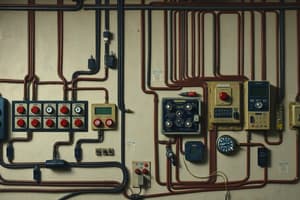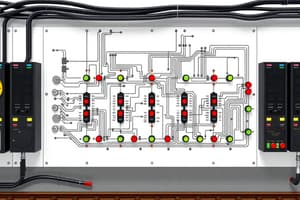Podcast
Questions and Answers
What is the primary function of a sensor in a control system?
What is the primary function of a sensor in a control system?
- Alters the system behavior
- Compares measured output with desired output
- Measures output (correct)
- Provides feedback to the actuator
In which type of circuit are signals represented as 0s and 1s?
In which type of circuit are signals represented as 0s and 1s?
- Analog Circuits
- Feedback Circuits
- Linear Circuits
- Digital Circuits (correct)
According to Kirchhoff's Voltage Law (KVL), what must be true about the sum of electrical potential differences around a loop?
According to Kirchhoff's Voltage Law (KVL), what must be true about the sum of electrical potential differences around a loop?
- It must equal zero (correct)
- It must equal the resistance in the circuit
- It must equal the total current entering the junction
- It must equal the total current leaving the junction
What component in a power system alters voltage levels for efficient transmission?
What component in a power system alters voltage levels for efficient transmission?
Which process converts a continuous signal into a discrete signal?
Which process converts a continuous signal into a discrete signal?
What is the outcome of a stable control system after a disturbance occurs?
What is the outcome of a stable control system after a disturbance occurs?
Which of the following describes the behavior of analog signals?
Which of the following describes the behavior of analog signals?
What is the main advantage of using alternating current (AC) systems in power transmission?
What is the main advantage of using alternating current (AC) systems in power transmission?
Which technique is used to analyze frequency components of a signal?
Which technique is used to analyze frequency components of a signal?
In circuit design, what does Ohm's Law express?
In circuit design, what does Ohm's Law express?
Study Notes
Control Systems
- Definition: A set of devices or set of mathematical models that manages, commands, directs, or regulates the behavior of other devices or systems.
- Components:
- Sensor: Measures output.
- Controller: Compares the measured output with the desired output.
- Actuator: Executes control decisions by altering the system behavior.
- Types:
- Open-loop systems: No feedback; output is not measured.
- Closed-loop systems: Feedback is used to adjust the control input.
- Stability: A system is stable if it returns to equilibrium after a disturbance.
- Frequency Response: Examines system stability and performance in the frequency domain.
Circuit Design
- Overview: The process of designing electronic circuits that implement specific functions.
- Key Concepts:
- Ohm’s Law: V = IR (Voltage = Current x Resistance)
- Kirchhoff's Laws:
- Current Law (KCL): The total current entering a junction equals the total current leaving.
- Voltage Law (KVL): The sum of electrical potential differences around a loop equals zero.
- Types of Circuits:
- Analog Circuits: Continuous signal representation.
- Digital Circuits: Discrete signal representation (0s and 1s).
- Simulation Tools: SPICE, Multisim for testing circuit designs.
Signal Processing
- Definition: The analysis, interpretation, and manipulation of signals.
- Types of Signals:
- Analog Signals: Continuous signals that vary over time.
- Digital Signals: Discrete values representing the signal.
- Techniques:
- Filtering: Removing unwanted components from the signal.
- Sampling: Converting a continuous signal into a discrete signal.
- Transformation: Fourier Transform to analyze signal frequency components.
- Applications: Telecommunications, audio processing, image processing.
Power Systems
- Definition: The network of electrical components that deliver electricity from producers to consumers.
- Key Components:
- Generators: Convert mechanical energy to electrical energy.
- Transformers: Alter voltage levels for efficient transmission.
- Transmission Lines: Carry electric power over long distances.
- Types:
- AC Systems: Alternating Current, used for long-distance transmission.
- DC Systems: Direct Current, used in certain applications like battery systems.
- Stability & Control: Ensures reliable and efficient operation of the power network.
Electromagnetics
- Definition: The study of electromagnetic forces, including electric fields and magnetic fields.
- Fundamental Principles:
- Coulomb’s Law: Describes the force between electrically charged objects.
- Faraday’s Law of Induction: A change in magnetic field can induce an electric current.
- Maxwell's Equations: A set of four equations that form the foundation of classical electromagnetism.
- Applications:
- Antennas: Used for radio frequency transmission and reception.
- Waveguides: Conduct electromagnetic waves.
- Electromagnetic Compatibility (EMC): Ensures devices operate without interfering with each other.
Control Systems
- Definition: A system that manages, commands, or regulates the behavior of other devices or systems.
- Components:
- Sensor: Measures the output of the system being controlled.
- Controller: Compares the measured output to the desired output and determines the necessary adjustments.
- Actuator: Takes the control decisions from the controller and alters the system behavior to achieve the desired output.
- Types:
- Open-loop systems: The output is not measured and there's no feedback mechanism.
- Closed-loop systems: Feedback is used to continuously adjust the control input based on the measured output, creating a loop of regulation.
- Stability: A system is stable if it returns to its equilibrium state after a disturbance.
- Frequency Response: Analyzes the system's stability and performance in the frequency domain, which relates to the system's response to various frequencies of input signals.
Circuit Design
- Overview: Designing electronic circuits that perform specific functions.
- Key Concepts:
- Ohm's Law: Relates voltage, current, and resistance in a circuit: Voltage (V) = Current (I) x Resistance (R).
- Kirchhoff's Laws:
- Kirchhoff's Current Law (KCL): The total current entering a junction (node) in a circuit is equal to the total current leaving the junction.
- Kirchhoff's Voltage Law (KVL): The sum of the voltage drops around any closed loop in a circuit is equal to zero.
- Types of Circuits:
- Analog Circuits: Circuits that process continuous signals, represented by continuously varying voltages or currents.
- Digital Circuits: Circuits that process signals represented by discrete values (0s and 1s), often used in computers and digital devices.
- Simulation Tools: SPICE and Multisim are commonly used to simulate and test circuit designs before physically building them.
Signal Processing
- Definition: The manipulation, analysis, and interpretation of signals to extract information.
- Types of Signals:
- Analog Signals: Continuous signals that vary over time, like the sound waves from a musical instrument.
- Digital Signals: Discrete signals, representing the information with a series of 0s and 1s, commonly used in computers and digital devices.
- Techniques:
- Filtering: Removing unwanted components (noise) from the signal.
- Sampling: Converting a continuous signal to a discrete signal by taking samples at specific intervals.
- Transformation: Using mathematical techniques like the Fourier Transform to analyze the frequency components of a signal.
- Applications: Signal processing is crucial for diverse fields like telecommunications, audio processing, image processing, and medical diagnostics.
Power Systems
- Definition: The network of electrical components that generate, transmit, and distribute electricity from power plants to consumers.
- Key Components:
- Generators: Convert mechanical energy (like from steam turbines or wind turbines) into electrical energy.
- Transformers: Increase or decrease voltage levels for efficient transmission and distribution of power.
- Transmission Lines: Carry high-voltage electricity over long distances.
- Types:
- AC Systems: Use Alternating Current (AC), where the current direction changes periodically; used for long-distance transmission.
- DC Systems: Use Direct Current (DC), where the current flows in a single direction; used in specific applications like battery systems.
- Stability & Control: The power system requires sophisticated control mechanisms to ensure reliable and efficient operation, preventing blackouts and maintaining voltage levels.
Electromagnetics
- Definition: The study of electromagnetic forces, including electric fields and magnetic fields.
- Fundamental Principles:
- Coulomb's Law: Describes the force between electrically charged objects.
- Faraday's Law of Induction: A changing magnetic field induces an electric current.
- Maxwell's Equations: Four fundamental equations that form the core of classical electromagnetism, providing a comprehensive description of electric and magnetic phenomena.
- Applications:
- Antennas: Used to transmit and receive radio waves.
- Waveguides: Conduct electromagnetic waves, used in high-frequency applications like microwave communication.
- Electromagnetic Compatibility (EMC): Ensures electronic devices function properly without interfering with each other, by controlling electromagnetic emissions and susceptibility to noise.
Studying That Suits You
Use AI to generate personalized quizzes and flashcards to suit your learning preferences.
Description
Test your knowledge on control systems and circuit design fundamentals. This quiz covers definitions, types of systems, and key concepts such as Ohm's Law and Kirchhoff's Laws. Hone your understanding of the components and stability in electronic systems.




